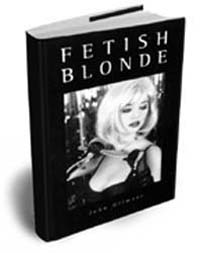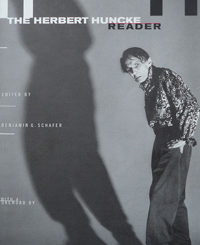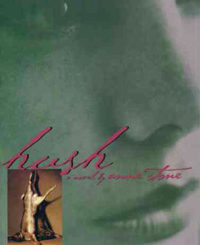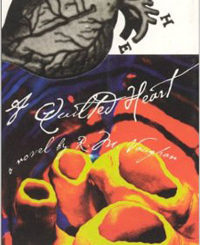 Fetish Blonde
Fetish Blonde
by John Gilmore (Creation Books, $16.95, 192 pp.)
by Thomas Christian
Albuquerque NM is an hour’s drive south of Santa Fe. Route-40 jags diagonally across its horizon, a crooked seam stitched along America’s belly that links sunny southern California with Arizona, Amarillo, Texas with Oklahoma, and Little Rock to Nashville, before dumping into the dense Atlantic off the coast of Cape Fear.
Late afternoon in Albuquerque. A big, gold sun bakes everything Adobe, paradise unveiled beneath a turquoise sky. The smell of juniper is in the air. Wrapped in a silver aluminum coat a roadside diner reflects a distorted image of bald-topped mountains and unbridled horses. A grotesque and decrepit saloon door swings like loneliness on a hinge of twilight in front of scores of aimlessly drifting tumbleweeds. Road signs point to Pueblo, Parajito, Los Lunas, and Chavez. Somewhere close by, John Gilmore is here also. Like the heat, melting away the pretty facade and exposing the sensitive nerves of America. “The air was blue with smoke and the stink of crack; a deadness to the music like the steady beating on the bottom of a wash tub…”
Love. Violence. A shoulders’ width apart at terror’s doorway. At any moment, sudden death, or illumination, or spontaneous orgasm, are all possible here, ground zero, where Gilmore sits and documents the time. A strange holiness pervades this place. “Rain was hitting the window and the gray light was splattered with shadows…”
John Gilmore was born in Hollywood shortly before the second world war. His mother was an actress under contract to MGM Studios; his father an officer of the L.A.P.D. assigned to the notorious murder case of Elizabeth Short, a.k.a. the “Black Dahlia.” The combined parental influence of celebrity/crime has inspired a lifetime of John Gilmore’s work.
In his book Severed: The True Story of The Black Dahlia Murder, Gilmore plays the hard-boiled detective with a flair for prose, accepting the grisly baton passed between generations. Donning the tan cloak of investigative reporter, he uncovers the persona of the infamous Charles Schmid (“The Tucson Murders”) and breaks bread with Charlie Manson (“The Garbage People”). Gilmore’s achieved a pop-celebrity status of sorts in his acquaintance with some of the 20th Century’s most notable characters. Lenny Bruce, Janis Joplin, Hank Williams, and Dennis Hopper all play a role in Gilmore’s book Laid Bare: A Memory of Wrecked Lives and the Hollywood Death Trap. An intimate friendship with James Dean (“We were bad boys playing bad boys,” he writes, “opening up the bisexual sides of our separate personalities”) is documented in Live Fast, Die Young: Remembering the Short Life of James Dean. Scribing the lives of madmen and celebrity has brought fans like William S. Burroughs and David Lynch. Recently, the British magazine Sight & Sound compared Gilmore’s style to a cross between Kerouac and Bukowski, and Maximum RockNRoll calls him “one of the best nonfiction writers of our time.”
In late 1950s Paris, a decadent Paris rich with both native and American expatriate literati, Gilmore scripted a fictional work that caught the eye of Maurice Girodias’ Olympia Press. The book, Fetish Blonde, has remained unpublished for forty years. With some era-adjusting notations, the book, Gilmore’s first work of fiction, is being brought to publication by Creation Books.
Fetish Blonde is a foot soldier’s guide beneath the metal, mortar, and glass of the architectural garbage created by the human machine, it claws at the ends of the shadows with a sharp stiletto, scraping away the darkness and uncovering emotional frenzy: “The image of the girl squeezing her body to the window like a laughing crucifix… her bare stomach trembling with her breath and the shiny metal ring in her navel clattering and scratching against the glass.” It’s graphically perverse, a seductive plunging into a mystery-filled underground comprised of psychotic tour guides: “Standing inside the door as if huddled against the chill, a tall transvestite in red plastic stared down at my cowboy boots,” necessitating a strong reliance on pure instinct to find a way out.
Outside the diner window, the desert sits quietly, waiting for a story. It’s fifteen minutes ’til Gilmore time. A waitress approaches with gray tobacco teeth and crooked, penciled-in eyebrows. Her uniform pulls tight against her gut; coffee stains dot the pale white ruffles of her sleeve.
What’ll it be mister?
A rectangular jukebox hangs on the wall.
Coffee please, I say to her.
“Rain Dogs,” “Black Rider,” “Tango ‘Till They’re Sore” – apparently I’ve stumbled onto the world’s first Tom Waits-only jukebox.
“She reminded me of the sea for some strange reason, water sliding across wet sand, slipping back and sucking into the deep.”
Ten minutes to Gilmore time and I haven’t a clue as to an opening question. The “icebreaker” is the all-important introductory inquisition that lays the foundation and gauges how the interview will go. To make matters worse, my waitress has vanished, leaving me sans coffee and company except for a headful of gravely Tom Waits tunes.
“I pushed the gun into her, then drew it out slowly, then pressed it into her again. ‘All the way!’ she said. ‘It’s all the way,’ I said. The trigger guard was knocking against her pubic bone.”
Six minutes to go. I looked out at the vacant diner lot. The sun was starting to fall in a golden mess. “I could feel her muscles tightening, stretching, the tender skin giving back to the steel.
‘Shoot it!’ she cried. ‘Shoot it in me!’
“Minutes to go. Madmen. Murderers. Empty deserts. I got a sudden longing for the East Coast, for going home, for getting the hell out of there. ”
‘Yes!’ she gasped. ‘Shoot me with it! Kill me-‘
I kept squeezing the trigger as she moaned and gasped…
I pulled the trigger – once – then again.
Snap! Snap!
I don’t listen to Tom Waits anymore.



